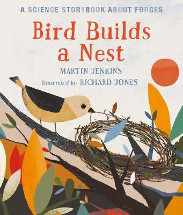Bird builds a nest by Martin Jenkins

A Science Storybook about Forces. Ill. by Richard Jones.
Walker Books, 2018. ISBN 9781406355130
(Ages: 3-7) Highly recommended. Themes: Forces, Push and Pull. In
the front matter we are given a brief introduction to forces: "This
is a book about forces. A force is something that makes an object
move, stop moving or change direction. We can apply a force by
pushing or pulling". The collage-like illustrations using earthy
colours are beautiful, depicting flowers and trees from the
endpapers and throughout. The narrative story itself is
distinguished from the information by different and larger type. The
story can be read alone but it also works very well when read
alongside the informative text. The explanations are clear and easy
for even the smallest children to understand. We are introduced to
Bird and follow her through the day as she builds her nest in
preparation for laying her eggs. First, she is hungry so she needs
to pull a worm out of the ground. The small text reads, "Bird is
getting ready to pull the worm. When you pull something, you are
applying a force towards you".
The illustrations support the explanation perfectly and allow young
children to tell the story using pictures alone (we see bird
straining to pull a large, strong worm and struggling to pick up
heavy and long twigs). It is made clear that some things are
possible for Bird based on her size and strength ("Bird can carry:
this quite large twig or two medium-sized twigs or three or four
small twigs") and some tasks are not possible or difficult (it shows
Bird exerting force on the actual nest that she is building as she
moves around it pushing it with her body). These are things that
children can actually relate to (pushing things with their body, the
ability to pick up things of different weights, sizes and
strengths). The book also touches on gravity and might lead to
discussions about how things can be a similar size but different
weights (she can carry many feathers and dried grass at once because
they are very light).
This is a really clever introduction to forces for those beginning
to understand the world around them and developing their scientific
vocabulary. The conversational tone is gentle and calm. At the end
of the book, there is an idea for an easy experiment using a ball of
clay and a ping-pong ball, which will be suitable for classrooms and
homes alike.
Nicole Nelson